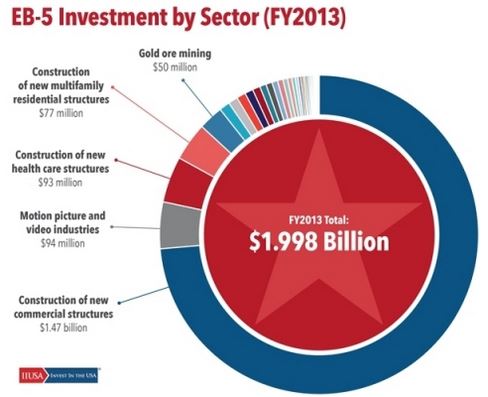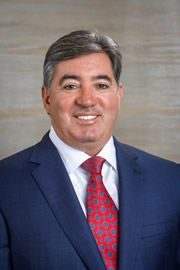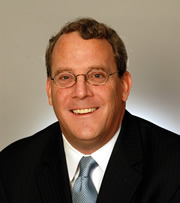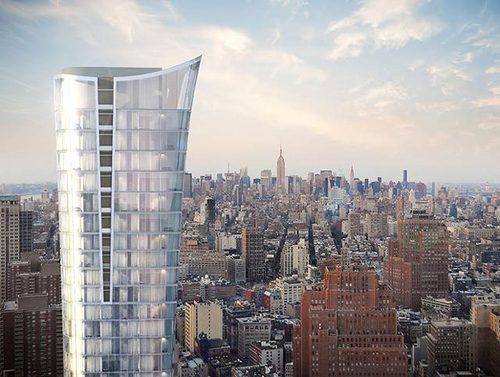It teeters on the brink of expiration next month. Its popularity among the Chinese in particular and some past malfeasance has sparked intensified scrutiny from the US State Dept. and Securities and Exchange Commission, respectively. And proposed changes to its requirements — tied inexorably to the larger issue of immigration reform — have made it yet another congressional hot potato.
We’re talking about EB-5, the individual foreign investor program overseen by USCIS that provides temporary and then permanent US citizenship to those willing to fork over at least $500,000 toward a project from a legitimate commercial enterprise that creates at least 10 actual jobs in two years in a qualifying high-unemployment or rural area (otherwise a $1-million investment is required). The initial vetting form, the I-526, offers conditional residence for those two years. The I-829, once approved, grants the investor, his/her spouse and any unmarried children under the age of 21 a 10-year green card, renewable indefinitely, which confers permanent resident status.
Investors may opt to invest individually or as part of a larger investor pool via a Regional Center, an entity that has been designated by USCIS to attract immigrant investors in specific geographic areas. States such as Washington and Oklahoma, among others, view EB-5 as a significant FDI attraction and economic development tool. With the program’s September 30th sunset date quickly approaching, a growing number of supporters are joining advocacy efforts supporting reauthorization. Both the U.S. Conference of Mayors and the National Association of Counties recently adopted resolutions affirming their support for the program, says Invest in the USA (IIUSA), a trade association representing more than 240 EB-5 Regional Centers.

According to FY 2015 second quarter data released June 2 by USCIS, the EB-5 program saw $989 million contributed to FDI in Q2, the highest total in program history. (Minimum FDI is calculated by multiplying the number of I-526 Approvals by the minimum investment amount $500,000). Through two quarters, EB-5 has contributed over $1.8 billion to U.S. FDI in 2015, compared to a total of $2.55 billion in FY 2014. There were 1,978 I-526 approvals during Q2, an increase of 20 percent from Q1 and 38 percent year-over-year.
According to US State Dept. statistics, EB-5 issuance has ballooned from 1,885 in 2010 to 10,692 in 2014.
“This is encouraging,” says IIUSA, “showing the Immigrant Investor Program Office (IPO) is increasing its capacity to adjudicate cases.”
There are over 13,000 EB-5 eligibility petitions pending approval with USCIS, which represent over $6.5 billion in potential FDI. Considering the amount invested so far, as well the number of petitions pending approval, EB-5 FDI in FY2015 is on track to nearly double the FDI from FY2013, says IIUSA.
A recent Savills Studley analysis puts the EB-5 program in context. “Every U.S. fiscal year … 140,000 employment-based immigrant visas are made available. The EB-5 program, which is one of five employment-based preference programs, limits the total number of investor visas to 7.1 percent of the employment-based total for any fiscal year, or 9,940. Of this amount, 3,000 visas per fiscal year are set aside for qualifying immigrants who invest in a TEA-designated [high-unemployment area] locale, while an additional 3,000 visas per year are set aside for investors in a Regional Center project.”

There are also limits according to country of origin, notes the report: “The total number of immigrant visas to natives of any foreign state made available under the family-sponsored immigrant visa program and the employment-based immigrant visa program in any fiscal year may not exceed 7 percent.”
In August 2014 those limits were apparently reached with respect to China, as the US State Dept. announced that the EB-5 preference category had become “unavailable” for Chinese applicants. The Savills Studley report noted that, “given the visa backlog and number of pending applications, the 2015 allotment of EB-5 visas for Mainland China applicants is likely to be reached before the end of the current fiscal year in September 2015, particularly if recent Chinese appetite for the visas is any indication.”
Over 85 percent of total EB-5 issuance in 2014 went to 9,128 individual investors from Mainland China.
Where They’re Going
IIUSA offers a useful EB-5 Economic Impact Map that demonstrates economic impacts generated by EB-5 investments at the state and congressional district levels from FY2010 to FY2013. The top 10 states over that time span are:
- California ($438.4 million, 6,085 jobs supported)
- New York ($379 million, 6,024 jobs)
- Florida ($150.5 million, 2,755 jobs)
- Texas ($174.2 million, 2,737 jobs)
- Maryland ($132.8 million, 2,042 jobs)
- Nevada ($121 million, 2,028 jobs)
- District of Columbia ($110 million, 1,584 jobs)
- Idaho ($65 million, 821 jobs)
- Virginia ($40.8 million, 736 jobs)
- Colorado ($35 million, 627 jobs)
The drop-off in jobs between the top five states and the next five is partly attributable to the fact that EB-5 is better known and utilized in some jurisdictions than others. It also corresponds to larger numbers for immigration as a whole, which can be broken down by metro area.
According to the U.S. Dept. of Homeland Security, of the 990,553 persons who obtained permanent resident status during FY 2013, 167,393 lived in the metro New York-New Jersey region — and 20,000 of them were from China. (Nationally, nearly 72,000 were from China, 135,000 were from Mexico and 68,000 were from India.) Second place goes to Greater Los Angeles, followed by, in order, Miami, D.C., Chicago, Houston, the Bay Area, Dallas-Fort Worth, Boston and Atlanta.
In other words, six of the top 10 metros for legal immigration were located in or near seven of the top 10 states for EB-5 impact.

“In terms of market desire from the foreign investor side, they see a rebound in the US for real estate, a rebound for project development,” says Ren Hayhurst, a partner at law firm Bryan Cave who usually represents banks financing businesses or development projects with EB-5 investors involved. Retail and office buildings are targets, but the bullseye is multifamily right now.
“Multifamily is a huge sector — that’s an area where investors look at it and they feel like they’re printing money if they do it correctly.”
Hayhurst cites a recent conversation with a national broker who told him every foreign investor coming to him wants to be involved in what Hayhurst calls “A-location retail centers,” i.e. primary and growing metros such as Los Angeles, San Diego, Dallas and Denver.
“Miami is coming back. Atlanta is coming back,” says Hayhurst. “So there are areas where clearly the municipality itself is a draw. But we’re also seeing them in secondary or tertiary markets like Omaha, Salt Lake City, and outside of Phoenix, where you’re right in the pathway of obvious growth.”
Big Influence in Big Apple
The Savills Studley report also notes the popularity of EB-5 in New York City: “Silverstein Properties’ regional center website (http://silversteinrc.com/) is marketing their Four Seasons Hotel New York, Downtown as an ‘EB-5 investment opportunity,’ while Related Companies’ website (http://www.relatedusa.com/) explains the EB-5 program in both English and Mandarin and has raised significant funding for its Hudson Yards project to date.”
New York is the sweet spot for U.S. Immigration Fund (USIF), a Jupiter, Fla.-based firm led by Nick Mastroianni II that specializes in EB-5 Regional Centers in New York, New Jersey and Florida, and has funded numerous developments in New York City. In late July, the list got longer with the groundbreaking for 101 TriBeCa, a 63-story, residential condo tower with 129 units available and the top-floor penthouses boasting 360-degree views.
Mastroianni’s firm is partnering with The Witkoff Group, Fisher Brothers and Howard Lorber’s New Valley Corp. on the $735-million development project, providing $175 million of funding through EB-5. The project is expected to create 4,548 jobs, and since the project’s inception, there have been a total of 342 foreign investors who have filed for residency, with 125 visas approved thus far.
A March 2015 report from top-shelf tenant rep Savills Study offers cogent analysis of EB-5 statistics and issues. Among its insights:
- EB-5 capital is generally cheaper than standard forms of bank lending or insurance company-issued debt; all things being equal, the greater the fraction of borrowing financed by EB-5 investors, the lower a developer’s overall borrowing costs.
- EB-5 funds are often deposited into escrow and released to a developer conditional on the government’s initial approval of the project. Should the project not be approved, EB-5 investment capital may evaporate, leaving a developer scrambling for last-minute financing and potentially delaying the construction process.
- Developers should be aware of the reputation that a given regional center has based on prior projects, particularly in light of several notable EB-5 investment scams over the past several years. Visa-seekers are unlikely to invest unless a Regional Center can prove that investments in prior projects yielded permanent Green Cards (and not just I-526 approvals).
- Other “less traditional” projects have included funding of a Riverside, Calif., solar panel delivery and installation company (SolarMax — via the Inland Empire Renewable Energy Regional Center) and North Dakota’s first new ethanol facility (Dakota Spirit AgEnergy— via CMB Export, LLC Regional Center).
In an interview, Mastroianni, who took a hit from a Fortune profile last year that explored numerous bankruptcies in his past, says he’s been working with EB-5 since 2009. Eighty percent of investors are from China. His firm doesn’t work with immigration lawyers, and has its feet on the ground with China offices.
“The US is new to the world of immigration,” he says. “China has an infrastructure of about 700 companies focused on emigration, and another 1,500 focused on education abroad. Cross-pollinate and you end up with a large coverage of people to emigrate, with probably 40 percent going to the US, and 60 percent to Hong Kong, Singapore, Australia, Macau and London.”
USIF has completed about 20 projects, with 18 in New York City, he says. The model is based on construction jobs created by long-term development projects, thus satisfying the two-year requirement of EB-5 rules. Speaking of Atlantic Yards, he says, “With the construction expenditures that take place on a project that’s $2 billion worth of infrastructure, the economic impact on that part of Brooklyn is tremendous — the workforce comes from all the boroughs in a five- to 10-mile radius.”
While construction jobs traditionally have not counted because of their transience, according to USCIS’ Adjudication Field Manual, direct construction jobs may now count as permanent jobs if they: 1) are created by the petitioner’s investment; and 2) are expected to last at least two years, inclusive of when the petitioner’s Form I-829 is filed.
“Look at Brooklyn 10 years ago and look at Brooklyn today,” says Mastroianni. “It’s astounding what’s happened there, and it’s happened because when capital markets were non-existent [due to the Great Recession], EB-5 existed. It lowered senior leverage to 50 percent in some cases. That definitely got construction going again, and now it’s mainstream and commonplace in capital stacks to see EB-5 in a mezzanine or preferred position.”
In a sense, the $4-billion Atlantic Yards project has traveled the full Chinese circle: In December 2013, Chinese multinational real estate developer Greenland Group agreed to become its majority owner-developer.
Mastroianni thinks Congress will pass some type of short-term extension, perhaps including stronger oversight and higher investment thresholds, “while they massage what looks like comprehensive immigration reform.”
Red Tape and Other Red Flags
Even with renewal in the near future, the EB-5 program has a past to escape, pocked with fraudulent projects, lack of oversight and, not least of its worries, I-526 and I-829 processing logjams that extend like those forms’ Interstate-sounding names suggest.
Problems with EB-5 fraudulence have surfaced in Chicago, California and Florida, with formal charges announced this summer alone by the SEC against a Bay Area oil and gas company and two Hong Kong-registered firms based in Boca Raton that were not properly registered as broker-dealers and steered EB-5 investments to certain Regional Centers in exchange for substantial commissions. The heat is on, and it was reflected in remarks made by USCIS Immigrant Investor Program Office Chief Nicholas Colucci during a teleconference held April 22, 2015 with EB-5 stakeholders”
“I want to remind all of our stakeholders, and specifically Regional Center principals, of the privilege of being a Regional Center designated by the United States,” he said. “It is a designation that allows you to help grow the American economy, create jobs, and help immigrant investors achieve their dreams. It is an exceptional business that you are in and we expect that you adhere to the requirements for continued eligibility. If we do detect you are operating outside of the laws and the regulations, we will seek to terminate your designation as an approved Regional Center.”

Chris Robertson, co-chair of law firm Seyfarth Shaw’s National Whistleblower Team and a member of the Complex Litigation, Capital Markets and Investment Management practice areas in the firm’s Boston office, is a former senior counsel in the SEC’s Division of Enforcement. He says regulators are just now wrapping their arms around a program that until recently had been largely ignored in terms of its security and fund sourcing issues. After all, most investors are going the EB-5 route for one main reason: getting those green cards for themselves and their family members.
“But independent of that, they’re handing over at least half a million dollars for a project that, most people would argue, they’re hoping to get back. There were few checks and balances on what disclosures were being made — ‘What am I actually investing in? What are the risks, time frames, and risk of losing the money?’ It necessarily is a situation where there has to be some risk. The SEC hadn’t been looking at any of this.”
Regulators today, he says, are “trying to figure out what the regulatory overlay would be — are Regional Centers acting as broker-dealers? Where’s the money going? All the things the SEC hadn’t been focused on, and now they are.”
Ren Hayhurst says the program’s hurdles from the investor and financing perspective begin with attaining that 10-job goal. It doesn’t seem like a lot to most companies, but almost by definition, EB-5 projects involve emerging firms.
“Established companies with employees are not the ones out there seeking this kind of investment,” he says. “They have good sources of capital and well established bank relationships. They don’t need to go out and seek foreign capital. A lot of companies that are emerging and in growth mode really could use this kind of capital, but they’re in a position where it’s uncertain if they’re going to be able to satisfy the immigration service there are 10 real jobs.”
From the development side, he says, “creating 10 new jobs is antithetical to what you’re trying to do. You’re trying to leverage what you already have, not bring on more salary and overhead. They are shocked when they find out they have to bring in more people, which is contrary to their business model as developers.”

The other big hurdle, says Hayhurst, and one getting bigger by the day, is tracing the sources of funds.
“There is huge pressure right now on any type of regulated financial institution,” he says, not just banks, but insurance companies too, which are adopting all manner of anti-terrorism provisions in documents because of the possibility of audited by federal or state regulators. In the dozens of EB-5 deals Hayhurst has seen, he has never seen evidence of ill-gotten gains or sheltering of funds. But at the same time, as he sees activity from all over Southeast Asia, one thing still shocks him.
“In the US, if you’re going to invest, we can run a credit check on you. In the rest of the world, including sophisticated economies like Japan or Australia, that doesn’t happen — you can’t get a credit report. We have an office in Singapore with Australian attorneys, and they can’t get me a credit report or a Dun & Bradstreet report. Recently I had a deal with a Japanese investor, and just could not get any background you would normally expect. It’s common not just for EB-5 deals, but for any foreign investment.”
That said, Hayhurst did help facilitate an EB-5 deal involving Japanese investors in a Canadian firm that repurposes industrial slag for cement and has various operations across several Western states.
“They were an exception because they were a mature company that was in a non-sexy industry,” Hayhurst explains, “so there was not a lot of domestic investor interest, but they had a 30-year track record, starting with a mining operation in Canada, which is now just 5 percent of what they do. They could meet the 10-job test. They got $2 million from the investor,” thanks to cooperation from the investor and from the Japanese government, “who were willing to provide us some information that allowed us to have reasonable comfort about the source of funds.”
Pure expense is yet another obstacle. For that Japanese investor, he says, about $300,000 came out of pocket to pay immigration lawyers in both countries.
Is This the Line?
According to IIUSA, despite the recent record-breaking numbers, there are still too many EB-5 petitions pending before the IPO office. In Q2 2015, there were a pending total of 13,663 I-526 petitions and 3,524 I-829 petitions. Average wait times were around 13 months, according to a check of the USCIS website earlier this week.
“We’ve gotten approvals on projects for people in as short as three weeks, and we’ve seen them go as long as 15 or 16 months,” says Nick Mastroianni. “The average waiting time for our projects is about 10 months. I think it has a lot to do with how much you complicate or do not complicate your templates for investors to file petitions. And we won’t underwrite projects that utilize all these indirect jobs.”
“In my experience, 13 months would be really good,” says Hayhurst. “In the successful deals we’ve seen, it’s been 15 months or more.”
That brings up a practical problem, he says, because the company’s capital needs and market opportunity are both occurring now.
“It’s a rare lender that will keep the conversation going for 15 months,” he says. “So there’s a real leap of faith that has to be taken by the US entity and the foreign investor to get themselves far down the track before they approach any lender to attain some leverage on their assets. That creates a real tension, and sense of frustration.”

Partly because of that lag, he says, in his experience the proportion of EB-5 projects that reach completion is less than 10 percent.
“Most of it is that time pressure, and the opportunity costs, as well as the window of time in the economy,” he says. “It’s incompatible with what people are looking to do. If you’re a smaller compay, part of what you offer is speed, and the ability to convince investors you can take an idea from beginning to end very quickly.”
Angelo Paparelli, a visible critic of the government’s lack of transparency and speed when it comes to EB-5 administration, oversees Seyfarth Shaw’s EB-5 Immigrant Investment Team. He says the delays have “created problems in terms of the infeasibility of using escrow arrangements. Now they’ve had to relax those because deals have to go forward. We’re still in an adolescent stage of development. It isn’t a mature program. We want to flush out and prosecute and penalize bad actors. We don’t want money-laundered funds to be investment, or have threats to national security. But the real problem is how quickly we can get where we need to be.”
Hayhurst compliments foreign investor programs he’s seen in Singapore and Canada. In Singapore, for instance, a liquor distribution company had three-, five- and 10-year goals. “There’s a greater flexibility in terms of job creation. And there’s a more realistic hurdle, meaning they give a longer time frame to build up job creation, as opposed to the EB-5 program that really wants to see something up front on day one. If you had some kind of graduated program that follows that model, it certainly would be easier for people to get their arms around.”
Like EB-5, the Canadian program was so popular with the Chinese that it was shut down in 2014 in order to “eliminate the backlog,” which some might read as cover for “not letting in any more Chinese.” A revised program launched in late 2014 requires a minimum investment equivalent to US$1.5 million, and that the investor speak English or French. According to published reports based on government data requests, the new program had received just six applicants as of June.
Angelo Paparelli is heartened by what he calls “reasonable additional regulation” of EB-5, considering its checkered past. And he’s equally heartened by rapidly increasing interest in EB-5 from institutional players. But he also foresees a shakeout: “We may see a smaller number of Regional Centers,” he says, “or see special-purpose Regional Centers that really are there only to promote the developers’ transactions.”
A ramp-up in staffing at the USCIS EB-5 office is predicated on the increasing EB-5 demand, but as one retired DHS official recently told Paparelli, if those regulations become too onerous or unreasonable, investors — even those hungry for those green cards — “will lose their appetite.”
Nick Mastroianni, however, sees a glass half full … if the spigot can be allowed to flow like it should.
“The market is very strong,” he says, noting demand from former Communist countries as well as nations such as India. There is a strong desire for people to emigrate, and the majority utilize it for their children. It’s families who want to live here. It hasn’t slowed down. And once we get our act together here and either extend or reauthorize, it will continue to be a strong source for capital projects.”

